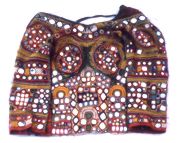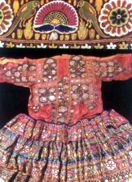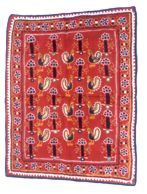|
The needle work of this important instruct in Kutch is generally known as Mochi embroidery. Mochi or the members of the shoe-maker community work in silk with a captivated needle like a broad and on silk cloth, Mashru, broad cloth, net and canvas. With a silk thread in one hand, the artists work with the other without any design sketched in the clothes or even placed before him and with wonderful speed forms letters, leaves, fruits, flowers, animals and human figures. Therefore, highly their skills valued that Kutch, Kathiawar and other chief centres employ them and their work is in great demand all over India and their work is sent to Zanzibar.

This embroidery is worked with the help of an ‘Aar' holded needle where the thread is introduced. This is also known as ‘Mochi Bharat' (Cobbler's stitch). In the earlier days, silk thread was used on smooth. Although the technique is simple in principle, it requires extensive skills and long practice. This art grew and prospered under the sponsorship of royal families in Kutch and Saurashtra. ‘Butti' of Persian origin peacocks in beautiful forms, stylized flowering scrubs and ‘Patli' were some of the decorative designs commonly used.
Nowadays, this embroidery has become destroyed. It is possible to see the samples of Mochi embroidery only in Aina Mahal, Kutch museum and Bharatiya Sanskriti Darshan in Bhuj.
Kutchi Bharat
‘Kutchi Bharat' with its complicated microscopic designs in attractive colours is considered to be the most outstanding and superb among the different types of Kutchi embroideries. This instructs derive its name from that vast extend of semi-desert land called Banni. It is represented by the Lohanas of Khavda, Jats, Mutvas, Harijans etc. of Banni. The Lohanas of Khavda dedicate themselves into skirt work and coverlets. The embroidery of Jats is extremely advanced.

The different types of Kutchi embroideries called as Kacho Bharat, Pako Bharat, Niran, Bharat, Kharek Bharat, Kambari Bharat, Chopad Bharat, Gufuo Bharat and Tanka Bharat.
When the men set out with their cattle and group, the women sit in the shades of their homes with needles and threads and they embroider and embroider and embroider. The young ones start to embroider articles which are kept till they come of age and carry of to there son-in-laws. They even have an offering sack (kothalo) in which they take all they have embroidered.

The festival blouses known as ‘Kanchali', the grant sack (Kothalo), the groom's marriage bags, the ‘Pothu', the doorways long curtains, the torans and a host of many other articles that are daily or for certain cheerful and special events and yet sold in the markets of many cities today.
The Sodhas are known for their soof embroidey and the Ahirs are well known for their chain sews up and the Jats' subgroups have their own styles of embroidery. The Rabaris and the jats have their own individual embroideries.

The most characteristic embroidery is the clothes of men, women and children of Kutch. Though, the styles are different from community to community and based on them alone can communities be well-known from each other.
The finest needle work today comes from many communities living in the Banni zone, a clean semi-desert region situated in the north direction of Bhuj and bordering Pakistan. The area is unreachable during the monsoon. The Harijans' village Hodko and the Muslim groups of Dhordo and Gorevali have been able to produce a large variety of decorative pieces for use in the profit-making municipal market.

Rabaris' decorative designs are made of flowers, decorative panels, a geometrical stylized horse and rider, peacocks and scorpions, worked in the chain stitch with round petal shaped and triangular mirrors scattered between them.
The Ahirs' chain stitch embroidery is advanced and more elaborate than the Rabaris' style. Young Ahir women wear ornately embroidered skirts in thick handspun cotton, generally green, red, blue or black while their backless bodices are in natural fiber Mashru fabric and heavily embroidered in chain stitch, buttonholes and herringbones stitch with mirrors. The most common decorative designs for their embroidered pieces are parakeets, flowers, women producing buttermilk, fan shaped half flowers or attractively decorated panels worked in rows, separated by bands of narrow geometric borders.
Traditional to Kutch is another style of embroidery known as ‘Hurmitch' and inspired from the Bavaliya tree-generally known as ‘thorny acacia'. It is an embroidery style worked almost completely with disconnected interweaving stitches arranged into various geometric patterns. In Hurmitch, stitch fabrics, the reverse surface of the cloth contrasts powerfully with the front. Separated interlacing decorative designs are attached to the base fabric only at the outer edges of the motifs. To create these insignificant separate fabrics, scaffolding twist spun threads are set up on the surface and the woven things are woven into the scaffolding with a needle. This results in small detached and separate designs of interlaced woven fabrics that lie above the surface of the base fabric.
The Mutva Jats of Banni embroider in an extremely fine style that is exclusive in Sindh and Kutch. This style of embroidery is characterized by geometrically decorative designs and sometimes white three or five petal flowers, worked in tiny square chain stitching often outlined with white consecutively stitches.
|